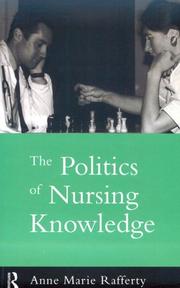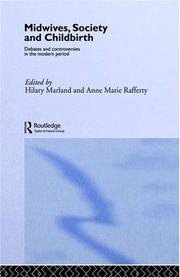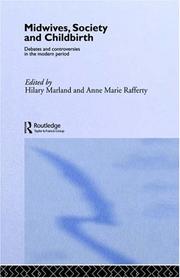| Listing 1 - 10 of 13 | << page >> |
Sort by
|

ISBN: 1280018674 020342896X 1134822057 9786610018673 9780203428962 9780415114912 0415114918 9780415114929 0415114926 9781134822003 9781134822041 9781134822058 1134822049 Year: 1996 Publisher: London ; New York : Routledge,
Abstract | Keywords | Export | Availability | Bookmark
 Loading...
Loading...Choose an application
- Reference Manager
- EndNote
- RefWorks (Direct export to RefWorks)
Focusing on the evolution of training and policy-making and highlighting contemporary issues confronting those in training, Anne-Marie Rafferty analyses how far nursing fits into the mould of both a profession and an academic discipline.
Nursing --- Professional socialization --- Occupational prestige --- Nurses --- Nurses and nursing --- Registered nurses --- RNs (Registered nurses) --- Medical personnel --- Job status (Occupational prestige) --- Occupational hierarchy --- Occupational status (Occupational prestige) --- Prestige --- Socialization --- Clinical nursing --- Nursing process --- Care of the sick --- Medicine --- Study and teaching --- Government policy --- Political aspects --- Social conditions.
Book
Year: 2019 Publisher: Copenhagen, Denmark : European Observatory on Health Systems and Policies,
Abstract | Keywords | Export | Availability | Bookmark
 Loading...
Loading...Choose an application
- Reference Manager
- EndNote
- RefWorks (Direct export to RefWorks)
'Who is a nurse?' and 'What is nursing?' seem to be simple questions yet the answers are strangely elusive. This book explores the variations in structure and organization of the nursing workforce across fourteen different countries in Europe. This diversity, and the reasons for it, are of more than academic interest. The work of nurses has always had a critical impact on patient outcomes. As health systems shift radically in response to rising demand, the role of nurses becomes even more important. The lessons learned from comparative case-study analysis demonstrate wide variation in every dimension of the workforce. It examines what a nurse is; nurse-to-doctor and nurse-to-population ratios; the education, regulation and issuing of credentials to nurses; and the planning of the workforce. While comparative analysis across countries brings these differences into sharp relief, it also reveals how the EU functions as an important 'binding agent', drawing these diverse elements together into a more coherent whole. This book is part of a two-volume study on the contributions that nurses make to strengthening health systems. This is the first time that the topic of nursing has been dealt with at length within the Observatory Health Policy Series. The aim is to raise the profile of nursing within health policy and draw the attention of decision-makers. Volume 1 is a series of national case studies drawn from Belgium, England, Finland, Germany, Greece, Ireland, the Netherlands, Norway, Poland, Spain, Sweden, and Switzerland. The countries were chosen as the subject of a large EU-funded study of nursing (RN4Cast). Lithuania and Slovenia were added to provide broader geographical and policy reach. Volume 2 will provide thematic analysis of important policy issues such as quality of care, workforce planning, education and training, regulation and migration.
Book
Year: 2019 Publisher: Copenhagen, Denmark : European Observatory on Health Systems and Policies,
Abstract | Keywords | Export | Availability | Bookmark
 Loading...
Loading...Choose an application
- Reference Manager
- EndNote
- RefWorks (Direct export to RefWorks)
'Who is a nurse?' and 'What is nursing?' seem to be simple questions yet the answers are strangely elusive. This book explores the variations in structure and organization of the nursing workforce across fourteen different countries in Europe. This diversity, and the reasons for it, are of more than academic interest. The work of nurses has always had a critical impact on patient outcomes. As health systems shift radically in response to rising demand, the role of nurses becomes even more important. The lessons learned from comparative case-study analysis demonstrate wide variation in every dimension of the workforce. It examines what a nurse is; nurse-to-doctor and nurse-to-population ratios; the education, regulation and issuing of credentials to nurses; and the planning of the workforce. While comparative analysis across countries brings these differences into sharp relief, it also reveals how the EU functions as an important 'binding agent', drawing these diverse elements together into a more coherent whole. This book is part of a two-volume study on the contributions that nurses make to strengthening health systems. This is the first time that the topic of nursing has been dealt with at length within the Observatory Health Policy Series. The aim is to raise the profile of nursing within health policy and draw the attention of decision-makers. Volume 1 is a series of national case studies drawn from Belgium, England, Finland, Germany, Greece, Ireland, the Netherlands, Norway, Poland, Spain, Sweden, and Switzerland. The countries were chosen as the subject of a large EU-funded study of nursing (RN4Cast). Lithuania and Slovenia were added to provide broader geographical and policy reach. Volume 2 will provide thematic analysis of important policy issues such as quality of care, workforce planning, education and training, regulation and migration.

ISBN: 113478600X 1280319364 0585452792 9786610319367 0203435893 9780585452791 9780203435892 9780415133289 0415133289 9781134786008 9781134785957 113478595X 9781134785995 1134785992 9781138868212 1138868213 9781280319365 6610319367 Year: 1997 Publisher: London ; New York : Routledge,
Abstract | Keywords | Export | Availability | Bookmark
 Loading...
Loading...Choose an application
- Reference Manager
- EndNote
- RefWorks (Direct export to RefWorks)
Questioning for the first time many conventional historical assumptions, this book is fundamental to a better understanding of the effect on midwives of the unprecedented progress of science, particularly obstetric science in 20th century.
Midwifery --- Nursing specialties --- Midwives --- History --- Social aspects
Periodical
Year: 2017 Publisher: Singapore : National University of Singapore Press,
Abstract | Keywords | Export | Availability | Bookmark
 Loading...
Loading...Choose an application
- Reference Manager
- EndNote
- RefWorks (Direct export to RefWorks)
This chapter has explored the role of training and education as a light- ning rod for rival models and interpretations of public health nursing. Nurses faced the constraints of conventional British social norms of class and gender in Malaya, contrasted with respect, status, and opportunities from North Americans. Hostility was displayed towards Americans within the Malayan medical services, affecting the way in which the RF-trained British nurses perceived colonial society, following their interaction with their friendlier and more egalitarian cross-Atlantic colleagues. The chapter also reveals how British, American, and international organizations' efforts and funding to improve public health nursing in rural areas coincided with periods of increased nationalism in the 1920s and communism in the late 1940s and early 1950s. In the 1920s, in particular, the RF, rather than the British, drove public health nursing in Malaya, enhancing health care in politically fragile rural areas.
Periodical
Year: 2017 Publisher: Singapore : National University of Singapore Press,
Abstract | Keywords | Export | Availability | Bookmark
 Loading...
Loading...Choose an application
- Reference Manager
- EndNote
- RefWorks (Direct export to RefWorks)
This chapter has explored the role of training and education as a light- ning rod for rival models and interpretations of public health nursing. Nurses faced the constraints of conventional British social norms of class and gender in Malaya, contrasted with respect, status, and opportunities from North Americans. Hostility was displayed towards Americans within the Malayan medical services, affecting the way in which the RF-trained British nurses perceived colonial society, following their interaction with their friendlier and more egalitarian cross-Atlantic colleagues. The chapter also reveals how British, American, and international organizations' efforts and funding to improve public health nursing in rural areas coincided with periods of increased nationalism in the 1920s and communism in the late 1940s and early 1950s. In the 1920s, in particular, the RF, rather than the British, drove public health nursing in Malaya, enhancing health care in politically fragile rural areas.

ISBN: 0415133289 Year: 1997 Volume: *4 Publisher: New York ; London Routledge
Abstract | Keywords | Export | Availability | Bookmark
 Loading...
Loading...Choose an application
- Reference Manager
- EndNote
- RefWorks (Direct export to RefWorks)
Midwifery --- Social aspects --- History --- Obstetrics --- Europe --- 19th century --- 20th century --- United States --- Midwifery - Europe - History - 19th century. --- Midwifery - Europe - History - 20th century. --- Midwifery - Social aspects - Europe. --- Midwifery - United States - History - 19th century. --- Midwifery - United States - History - 20th century. --- Midwifery - Social aspects - United States. --- Vroedkunde

ISBN: 1134978715 1280018747 9786610018741 0203403312 9780203403310 0203711556 9780203711552 9781280018749 0415017866 0415017858 9781134978663 9781134978700 9781134978717 9781138140110 9780415017862 1134978707 Year: 1988 Publisher: London Routledge
Abstract | Keywords | Export | Availability | Bookmark
 Loading...
Loading...Choose an application
- Reference Manager
- EndNote
- RefWorks (Direct export to RefWorks)
In recent years the study of nursing history in Britain has been transformed by the application of concepts and methods from the social sciences to original sources. The myths and legends which have grown up through a century of anecdotal writing have been chipped away to reveal the complex story of an occupation shaped and reshaped by social and technological change. Most of the work has been scattered in monographs, journals and edited collections. The skills of a social historian, a sociologist and a graduate nurse have been brought together to rethink the history of modern nursing.
Nursing --- Care of the sick. --- Caring for the sick --- Sick, Care of the --- Sick --- Home nursing --- Clinical nursing --- Nurses and nursing --- Nursing process --- Care of the sick --- Medicine --- History. --- Soins infirmiers --- Histoire
Book
ISBN: 9781526140784 1526140780 Year: 2021 Publisher: Manchester : Manchester University Press,
Abstract | Keywords | Export | Availability | Bookmark
 Loading...
Loading...Choose an application
- Reference Manager
- EndNote
- RefWorks (Direct export to RefWorks)
Germs and governance brings together leading historians, practitioners and policymakers to consider the past, present and future of hospital infection control. Combining historical case studies with practitioner experiences, this volume offers a new understanding of the emergence of theories of germ transmission and containment and how these theories played out in real-world environments, networks and professional organisations. Exploring the historical context in which technologies like gloves were developed and popularised, as well as how relationships between communities and hospitals, doctors and nurses, and the emerging role of hospital bacteriologists have shaped infection control practices, the collection emphasises the diverse contexts in which ideas about germs, infection and safety circulated. It addresses the historical neglect of the critical role of nurses in infection control, arguing that nurses represent a touchstone for understanding the development and success of infection control measures. Moving beyond the linear narratives of discovery, milestones and prominent figures found in earlier accounts of hospital infection, this interdisciplinary collection makes use of a variety of methodological approaches, including health services research, historical analysis and economic, sociological and anthropological exploration of key words, concepts and attitudes.
Nosocomial infections --- Hospitals --- Hospital buildings --- Prevention --- Administration --- Sanitation --- History.
Book
ISBN: 9813250356 9814722057 Year: 2017 Publisher: National University of Singapore Press
Abstract | Keywords | Export | Availability | Bookmark
 Loading...
Loading...Choose an application
- Reference Manager
- EndNote
- RefWorks (Direct export to RefWorks)
Two distinct nursing styles fought for dominance within the nursing world in the interwar period and British Malaya provides a historical laboratory with which to study the varied goals of British and North American nursing.
Traditional medicine --- Medicine, Chinese --- Medicine, Chinese. --- Traditional medicine. --- History. --- Southeast Asia. --- Ethnic medicine --- Ethnomedicine --- Folk medicine --- Home cures --- Home medicine --- Home remedies --- Indigenous medicine --- Medical folklore --- Medicine, Primitive --- Primitive medicine --- Surgery, Primitive --- Alternative medicine --- Folklore --- Medical anthropology --- Ethnopharmacology --- Chinese medicine --- TCM (Medicine) --- Traditional Chinese medicine --- Asia, Southeastern --- South East Asia --- Southeastern Asia
| Listing 1 - 10 of 13 | << page >> |
Sort by
|

 Search
Search Feedback
Feedback About UniCat
About UniCat  Help
Help News
News